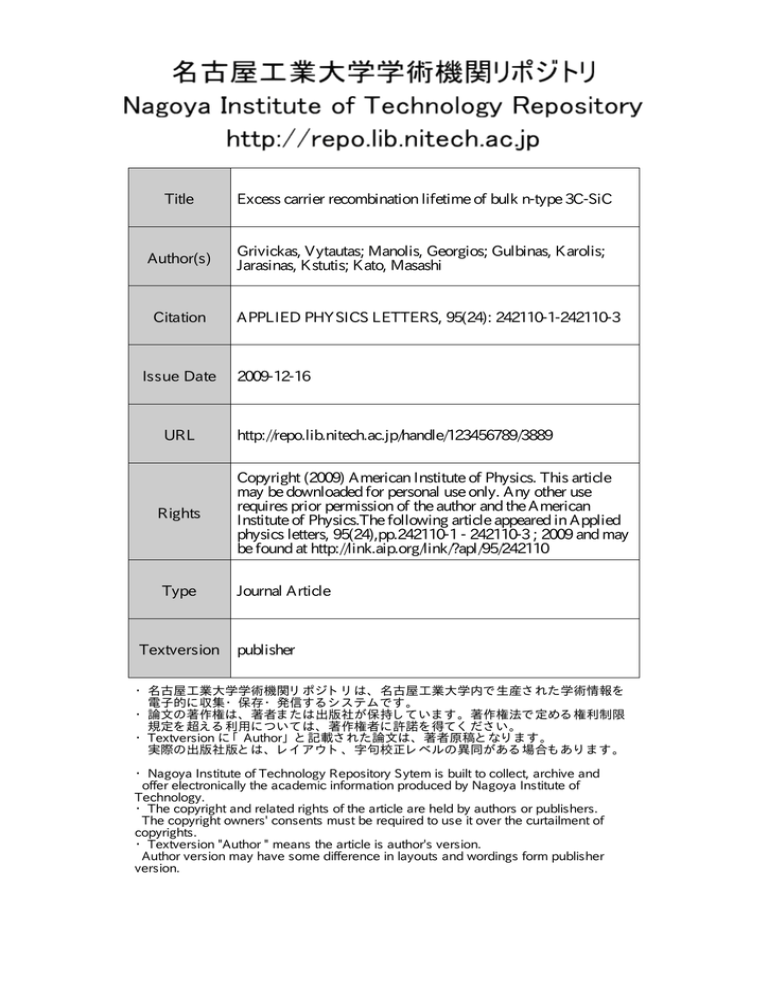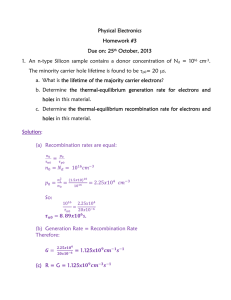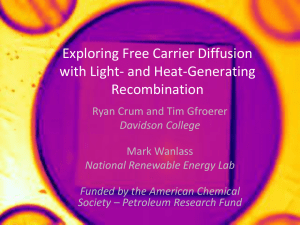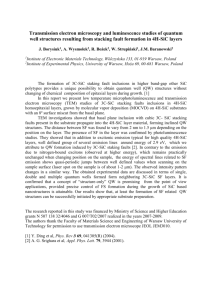Title Excess carrier recombination lifetime of bulk n-type 3C
advertisement

Title Excess carrier recombination lifetime of bulk n-type 3C-SiC Author(s) Grivickas, Vytautas; Manolis, Georgios; Gulbinas, Karolis; Jarasinas, Kstutis; Kato, Masashi Citation Issue Date URL Rights Type Textversion APPLIED PHYSICS LETTERS, 95(24): 242110-1-242110-3 2009-12-16 http://repo.lib.nitech.ac.jp/handle/123456789/3889 Copyright (2009) American Institute of Physics. This article may be downloaded for personal use only. Any other use requires prior permission of the author and the American Institute of Physics.The following article appeared in Applied physics letters, 95(24),pp.242110-1 - 242110-3 ; 2009 and may be found at http://link.aip.org/link/?apl/95/242110 Journal Article publisher ・名古屋工業大学学術機関リポジトリは、名古屋工業大学内で生産された学術情報を 電子的に収集・保存・発信するシステムです。 ・論文の著作権は、著者または出版社が保持しています。著作権法で定める権利制限 規定を超える利用については、著作権者に許諾を得てください。 ・Textversion に「Author」と記載された論文は、著者原稿となります。 実際の出版社版とは、レイアウト、字句校正レベルの異同がある場合もあります。 ・Nagoya Institute of Technology Repository Sytem is built to collect, archive and offer electronically the academic information produced by Nagoya Institute of Technology. ・The copyright and related rights of the article are held by authors or publishers. The copyright owners' consents must be required to use it over the curtailment of copyrights. ・Textversion "Author " means the article is author's version. Author version may have some difference in layouts and wordings form publisher version. APPLIED PHYSICS LETTERS 95, 242110 共2009兲 Excess carrier recombination lifetime of bulk n-type 3C-SiC Vytautas Grivickas,1,a兲 Georgios Manolis,1 Karolis Gulbinas,1 KJstutis Jarašiūnas,1 and Masashi Kato1,2 1 Institute of Applied Research, Vilnius University, Saulėtekio 10, LT-10223 Vilnius, Lithuania Department of Engineering Physics, Electronics and Mechanics, Nagoya Institute of Technology, Gokiso, Showa, Nagoya 4666-8555, Japan 2 共Received 10 August 2009; accepted 18 November 2009; published online 16 December 2009兲 Transient absorption technique was used to determine carrier lifetimes in 3C-SiC grown on Si and 6H-SiC substrates. A slow lifetime component originated from minority carrier traps and pointed out to the trap saturation with increasing injection. Recombination lifetime in different samples varied between 0.5–120 ns. Its value decreased with excess carrier density in the transition range between minority-carrier-lifetime and high-injection lifetime but abnormally increased above the carrier density of 2 ⫻ 1017 cm−3. Negligible contribution of surface and Auger recombination to recombination lifetime peculiarities was observed. Possible mechanisms of the observed lifetime variation are discussed. © 2009 American Institute of Physics. 关doi:10.1063/1.3273382兴 Electrical properties of cubic silicon carbide 共3C-SiC兲 make this polytype an attractive candidate for many high power device applications. Bulk growth of this polytype, however, is complicated as 3C-SiC is the least stable form of SiC with the smallest 2.36 eV indirect band gap among all SiC polytypes. Epitaxial deposition of 3C-SiC layers was suggested on the 共001兲 face of the Si substrates and the 共0001兲 face of the 6H-SiC substrates.1 During the last decade both growth methods improved substantially and 100 m thick freestanding n-type 3C-SiC wafers with high material purity were demonstrated.2 Excess carrier lifetime is a sensitive indicator of a single crystal quality. Exact lifetime values are needed for modeling of electronic devices. In contrast to other polytypes,3–8 dominant recombination mechanisms in 3C-SiC are poorly understood. Under low-level 共LL兲 excitation 共⌬n Ⰶ n0, where ⌬n and n0 are the excess and the equilibrium electron concentrations, respectively兲, carrier decays in 3C-SiC were obtained by microwave9 and photoconductivity10 techniques. Both techniques showed that carrier decay is consisting of the initial fast 共R ⬇ 1 – 15 s兲 part and the subsequent slow 共S ⬎ 1 ms兲 tail. The initial part was assigned to the recombination through active recombination levels while the appearance of the tail was attributed to the minority carrier trapping by the deep band gap centers. The effect of a high build-in strain11 between the thin 3C-SiC epitaxial layers and the Si substrates was not considered in these studies. Under high-level 共HL兲 excitation 共⌬n Ⰷ n0兲, excess carrier decays were studied using the four wave mixing 共FWM兲 technique.12,13 High temporal resolution of these experiments showed the fast decays with the 1–4 ns and, at high carrier concentrations, an increase of the lifetime was registered as opposed to the conventional lifetime decrease owing to the Auger recombination mechanism. In this letter, we report an investigation of carrier recombination processes in thick, freestanding 3C-SiC samples using the time- and spatially resolved free-carrier-absorption 共FCA兲 techniques. A wide injection range, covering transitioning from LL to HL excitation regimes, was achieved in our experiments and thus a兲 Electronic mail: vytautas.grivickas@ff.vu.lt. 0003-6951/2009/95共24兲/242110/3/$25.00 allowed to get insight into recombination mechanisms controlling the bulk lifetime of 3C-SiC. Three different 3C-SiC samples, two grown on the Si substrates and one grown on the 6H-SiC substrate, were investigated in this work. Free standing wafers were obtained by removing the substrates with chemical etching and/or mechanical polishing. The bulk sample growth is described in Ref. 13. Sample labeling, wafer thicknesses d, and concentrations n0 at room temperature are provided in Table I. The inset of Fig. 1 shows schematically the two measurement geometries used in the pump-probe experiments. In the or- FIG. 1. 共Color online兲 共a兲 Transient concentration ⌬n共t兲 in 3C-SiC samples at injection density of 1018 cm−3, when excited by 2.384 eV energy photon pulses at 295 K. Exponential fit is applied to the initial decay. In the inset, two transients on H1 sample are shown for lower injections over a longer time scale. 共b兲 Injection dependences of transient concentration magnitude at 77 K excited by 2.53 eV. Peak concentration ⌬nPK 共squares兲 and saturated concentration ⌬nS 共triangles兲 is shown for H2 and B4 samples. Inset shows experimental configuration for measurement under orthogonal and collinear geometries. 95, 242110-1 © 2009 American Institute of Physics Downloaded 25 Aug 2010 to 133.68.192.95. Redistribution subject to AIP license or copyright; see http://apl.aip.org/about/rights_and_permissions 242110-2 Appl. Phys. Lett. 95, 242110 共2009兲 Grivickas et al. thogonal geometry, used for excitations up to 2 ⫻ 1018 cm−3, the cross-cut side of 3C-SiC wafer was homogeneously excited with a 2 ns duration laser pulse. Nearly constant distribution of excited carriers was achieved along the z-direction of the wafer by tuning the excitation wavelength close to the band gap of 3C-SiC. The induced excess carrier dynamics was detected by the FCA decay, ⌬␣共t , z兲, of the continuous probe beam propagating perpendicularly to the excited lateral surface. Concentration of the excess electron and hole 共e-h兲 pairs was directly proportional to the induced absorption changes: ⌬n共t , z兲 = ⌬␣共t , z兲 / eh, where the FCA cross-section eh = 1.4⫻ 10−17 cm2 was obtained for the 1.54 m wavelength probe beam using the established calibration procedure.14 Scans along the z-direction were obtained while the resolution of the probe beam within the sample was 8 m. In the collinear geometry, used for excitations above 2 ⫻ 1018 cm−3, both pump and probe beams were directed to the same point on the wafer surface. Excitation was done with a different laser generating 25 ps duration pulses at 351 nm wavelength and probing was done with an optically delayed probe beam at 1.05 m wavelength. The induced absorption changes, ⌬␣共t兲, were detected by delaying the probe pulses with respect to the excitation pulses where eh = 1 ⫻ 10−17 cm2 was set for the 1.05 m wavelength. An integrated injected carrier concentration ⌬nIN values of e-h pairs was calculated using the known photon flux at the sample surface and the known absorption coefficient ␣ of the excitation wavelength. For 351 nm wavelength the absorption depth ␣−1 is about equal to about 5 m.12,13 Figure 1共a兲 shows carrier decays detected in all three samples at the injected carrier concentration of ⌬nIN ⬇ 1018 cm−3. In the H1 and H2 samples, grown on the Si substrates, the initial part of the decays was almost a single exponent with the excess carrier recombination lifetimes R in the order of 100 ns. At longer times, the decays diverged into the slow milliseconds component initiating at the saturated ⌬nS concentration 关see the inset of Fig. 1共a兲兴. In the B4 sample, grown on the 6H-SiC substrate, the peak measured concentration, ⌬nPK, was much smaller than ⌬nIN indicating that R is comparable to the duration of the excitation laser pulse. The initial fast decay was again followed by the slow milliseconds component with the ⌬nS magnitude values substantially higher than in the H1 and H2 samples. Figure 2共b兲 shows ⌬nPK 共solid symbols兲 and ⌬nS 共open symbols兲 in the H2 and B4 samples plotted versus ⌬nIN. In both samples ⌬nPK was linearly dependent on ⌬nIN, while ⌬nS was saturating at higher ⌬nIN. Gradual saturation behavior is typical for minority carrier trapping by deep band gap centers.6,9,10 The ⌬nS limit at high injected concentrations was equated to the total density of filed traps, NT, assuming that the electron is dominating the FCA cross-section: e ⬇ eh. The NT values are presented in Table I. FIG. 2. 共Color online兲 共a兲 Z-distributions of ⌬n共t , z兲 at different times after 2.48 eV photon pulse excitation in H1 sample at 295 K. Z共0兲 position matches to the excited surface. 共b兲 Histogram of R values from different locations and the corresponding Gaussian fit for two indicated injection concentrations ⌬nIN. Effect of surface recombination to the measured R values was evaluated using z-scans of carrier decays.6,7 Figure 2共a兲 shows ⌬n共t , z兲 profiles detected along the z-direction of the H1 sample at different moments after the excitation pulse 共⌬nIN ⬇ 3 ⫻ 1017 cm−3兲. No tangible reduction of ⌬n at 10 m distance from the surface was observed during the decay times equating several R. The carrier decay diffusion profile evolution was simulated through the one-dimensional model15 using the measured ambipolar carrier diffusion coefficient value Da ⬇ 3.3 cm2 / s.13 The calculations showed that the upper limit of surface recombination rate S is 103 cm/ s. This value is smaller than the 103 – 105 cm/ s range of rates determined for the mechanically polished surfaces of 4H- and 6H-SiC polytypes7 and does not significantly affect the measured R values in 3C-SiC. Statistical distribution of lifetimes at different sample places was also evaluated using z-scans. Vertical bars in Fig. 2共b兲 show R distribution in the H1 sample obtained during the 20 m step along the z-direction. The detected distribution was well fitted using the Gaussian function as shown by the solid line. The same Gaussian distribution was characteristic for higher ⌬nIN as illustrated by the dashed line. Statistical lifetime averages and their spreads at the FWHM are provided in Table I for all samples at ⌬nIN = 2 ⫻ 1017 cm−3. The detected ratio between the average values and their spreads compares to the results obtained in the other polytypes of SiC.7 Dominant recombination mechanisms in 3C-SiC were determined from the R measurements at different ⌬nIN. In order to separate these changes from the statistical R variations within the sample, special care was taken probing samples at the same position. Figure 3 shows R共⌬nIN兲 dependence measured in H1 共triangles兲 and H2 共squares兲 samples at 295 K 共open symbols兲 and 77 K 共solid symbols兲. The circled symbols in the figure show the precise R value TABLE I. Sample labeling and basic parameters at room temperature. Sample H1 共on Si兲 H2 共on Si兲 B4 共on 6H-SiC兲 Thickness d共m兲 Equilibrium density n0共cm−3兲 R共ns兲 at ⌬n = 2 ⫻ 1017 cm−3 Trap density NT共cm−3兲 255 160 800 共3 – 5兲 ⫻ 1015 共1 – 3.5兲 ⫻ 1017 N = 共1 – 5兲 ⫻ 1016 at/ cm3 55 共spread ⫾17兲 88 共spread ⫾42兲 0.8 共7 – 10兲 ⫻ 1014 3.6⫻ 1015 1.45⫻ 1016 Downloaded 25 Aug 2010 to 133.68.192.95. Redistribution subject to AIP license or copyright; see http://apl.aip.org/about/rights_and_permissions 242110-3 Appl. Phys. Lett. 95, 242110 共2009兲 Grivickas et al. FIG. 3. 共Color online兲 Recombination lifetime R vs excess carrier density in three 3C-SiC samples. Dashed and solid line is the guide for the eye for injection dependences at 295 K and at 77 K, respectively. of the initial fast decay of the B4 sample at room temperature, which were determined by the FWM technique.13 The steep decrease of lifetime observed in the H2 sample at 295 K above 1019 cm−3 appeared due to the Auger recombination. The ␥ = 2.5⫻ 10−32 cm6 / s Auger coefficient was extracted from the ␥ = 共R ⫻ ⌬n2兲−1 data fits.16 This ␥ value was found thirty times smaller than the one obtained in the 4HSiC polytype.7 The result can be explained by the difference in the band structures of the two polytypes. In the direct e-e-h Auger process, the 2Eg共X1C − ⌫15V兲 ⱖ Eg共⌫1C − ⌫15V兲 requirement has to be satisfied, where Eg共X1C − ⌫15V兲 is the indirect band gap and Eg共⌫1C − ⌫15V兲 is the direct gap at the ⌫-symmetry point. While this requirement is almost fulfilled in 4H-SiC polytype, there is ⬃1.3 eV deficit in the band structure of the 3C-SiC polytype. Therefore, the weak phonon-assisted Auger process is the most likely recombination mechanism in 3C-SiC at high injections. In the ⌬nIN range 5 ⫻ 1015 – 5 ⫻ 1018 cm−3, the R dependency in all samples at room temperature had a V-shape. This dependency became even more pronounced in H1 and H2 samples at 77 K. The standard Shockley–Read–Hall 共SRH兲 theory for a single recombination center in a forbidden gap can explain only S-shape 共deep center兲 or a reverse S-shape 共shallow center兲 dependencies.17 The same theory for two noninteracting deep and shallow centers can explain mixed injection dependency which produces namely the ⌳-shape. Such lifetime nonlinearity was demonstrated in p-type Si, where simultaneous recombination through the Fe interstitial impurity and the FeB acceptor-pair was observed.18,19 In addition, according to the SRH theory a lifetime peak should occur around the LL/HL transition 共⌬n ⬃ n0兲 on ⌳-shape injection dependencies. This contradicts the clear shift of the lifetime minima on V-shape in 3C-SiC to the higher ⌬nIN values with decreasing temperature 共Fig. 3兲, while the substantial n0 reduction by factor of 1/20 is measured with decreasing temperature to 77 K in moderately doped n-type 3C-SiC.2 It is believed that recombination in 3C-SiC should occur through the defect level similar to the Z1 / Z2 center detected in 4H-SiC.3,5,8 This center originates from the carbon vacancy-related complexes on the cubic and hexagonal sites and dominates an intrinsic lifetime of the 4H-SiC polytype. Despite the complicated injection dependent nature of the center, which has three possible charge states, the constant HL-lifetime values are observed in 4H-SiC before up to the onset of the Auger recombination.7,8 We speculate that the V-shape dependency in 3C-SiC originates from the dynamic capture barrier for the majority electrons due to the lattice relaxation around the different charge states of this defect. In 4H-SiC polytype deep level transient spectroscopy measurements showed that the Z1 / Z2 center has the large minority hole capture cross-section sh ⬇ 10−14 cm2 and two electron capture cross-sections of the order se ⱖ 10−15 cm2. Using these values and the simple HL ⬇ 共vth ⫻ se ⫻ NR兲−1 relation, where vth is the thermal velocity and NR is the defect concentration, we estimate that NR ⬇ 1014 – 1015 cm−3 in the H1 and H2 samples, and NR ⬇ 1016 cm−3 in the B4 sample. These values are by one or two orders of magnitude higher than the ones observed in high quality 4H-SiC epilayers. This work is supported by the EU FP6 Contract No. MRTN-CT-2006-35735, by the Swedish Visby program, and by Lithuanian State and Studies Foundation. We also thank Professor J. Linnros for access to experimental equipment at Royal Institute of Technology. R. F. Davis and J. T. Glass, Advances in Solid State Chemistry 共JAI, Oxford, 1991兲, Vol. 2, pp. 1–111. 2 T. Yamada and K. M. Itoh, Mater. Sci. Forum 389–393, 675 共2002兲. 3 M. Kawai, T. Mori, M. Kato, M. Ichimura, S. Sumie, and H. Hashizume, Mater. Sci. Forum 556–557, 359 共2007兲. 4 S. A. Reshanov, K. Schneider, R. Helbig, G. Pensl, H. Nagasawa, and A. Schöner, Mater. Sci. Forum 457–460, 513 共2004兲. 5 J. P. Bergman, Diamond Relat. Mater. 6, 1324 共1997兲. 6 P. Grivickas, A. Galeckas, J. Linnros, M. Syväjärvi, R. Yakimova, V. Grivickas, and J. A. Tellefsen, Mater. Sci. Semicond. Process. 4, 191 共2001兲. 7 A. Galeckas, J. Linnros, M. Frichholz, and V. Grivickas, Appl. Phys. Lett. 79, 365 共2001兲. 8 P. B. Klein, J. Appl. Phys. 103, 033702 共2008兲. 9 M. Ichimura, H. Tajiri, Y. Morita, N. Yamada, and A. Usami, Appl. Phys. Lett. 70, 1745 共1997兲. 10 M. Ichimura, N. Yamada, H. Tajiri, and E. Arai, J. Appl. Phys. 84, 2727 共1998兲. 11 A. Galeckas, A. Yu. Kuznetsov, T. Chassagne, G. Ferro, J. Linnros, and V. Grivickas, Mater. Sci. Forum 457–460, 657 共2004兲. 12 K. Neimontas, K. Jarašiūnas, M. Soueidan, G. Ferro, and Y. Monteil, Mater. Sci. Forum 556–557, 395 共2007兲. 13 G. Manolis, K. Jarašiūnas, I. G. Galben, and D. Chaussende, Mater. Sci. Forum 615–617, 303 共2009兲. 14 P. Grivickas, V. Grivickas, and J. Linnros, Phys. Rev. Lett. 91, 246401 共2003兲. 15 V. Grivickas, L. Linnros, A. Vigelis, J. Šečkus, and J. A. Tellefsen, SolidState Electron. 35, 299 共1992兲. 16 K. Jarašiūnas, P. Ščajev, V. Gudelis, P. B. Klein, and M. Kato, Int. Conf. on SiC and Related Materials, Technical Digest, Paper I-148, Nurnberg, 2009. 17 J. Linnros, J. Appl. Phys. 84, 275 共1998兲. 18 D. Macdonald, A. Cuevas, and J. Wong-Leung, J. Appl. Phys. 89, 7932 共2001兲. 19 D. Macdonald and A. Cuevas, Phys. Rev. B 67, 075203 共2003兲. 1 Downloaded 25 Aug 2010 to 133.68.192.95. Redistribution subject to AIP license or copyright; see http://apl.aip.org/about/rights_and_permissions




